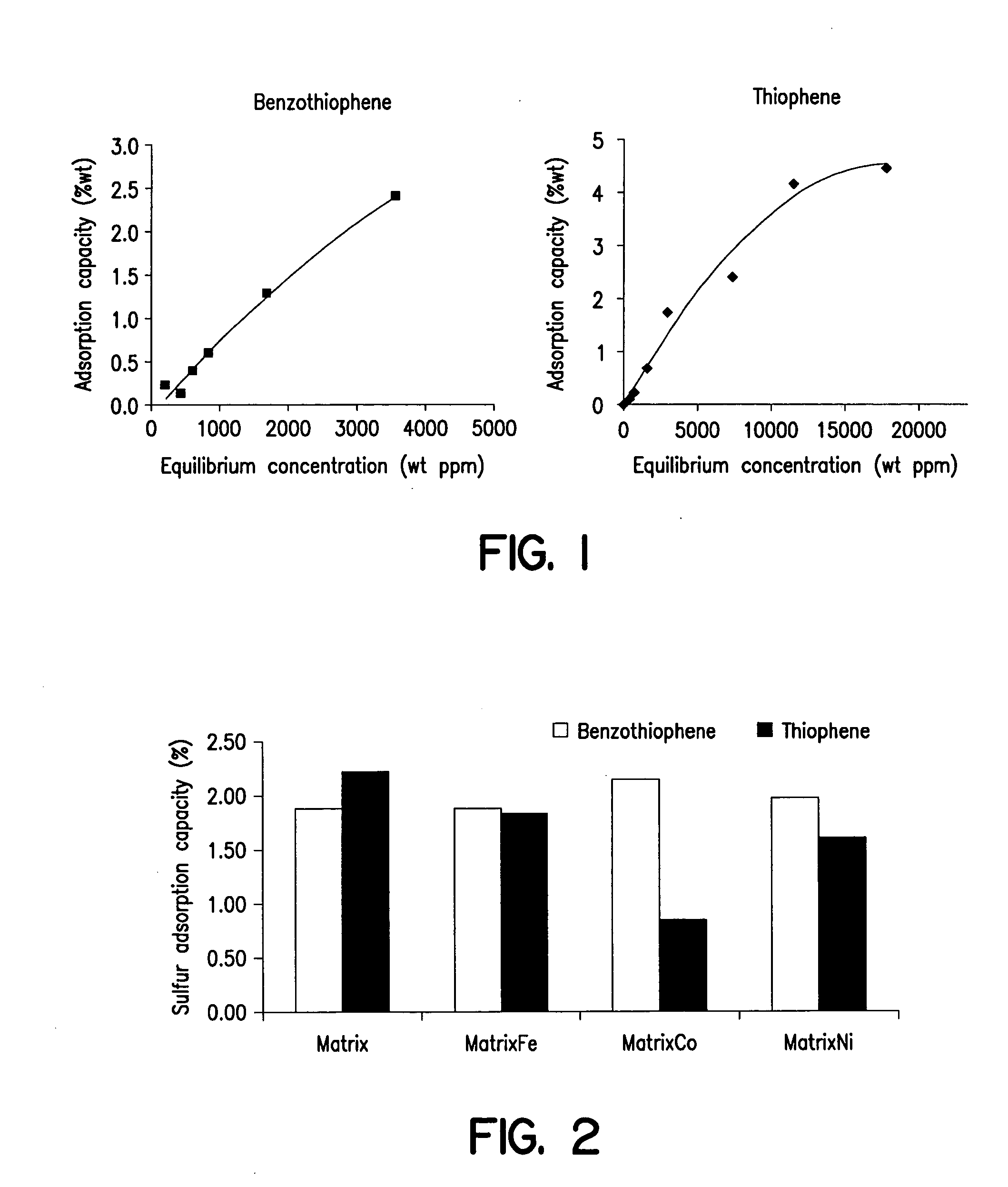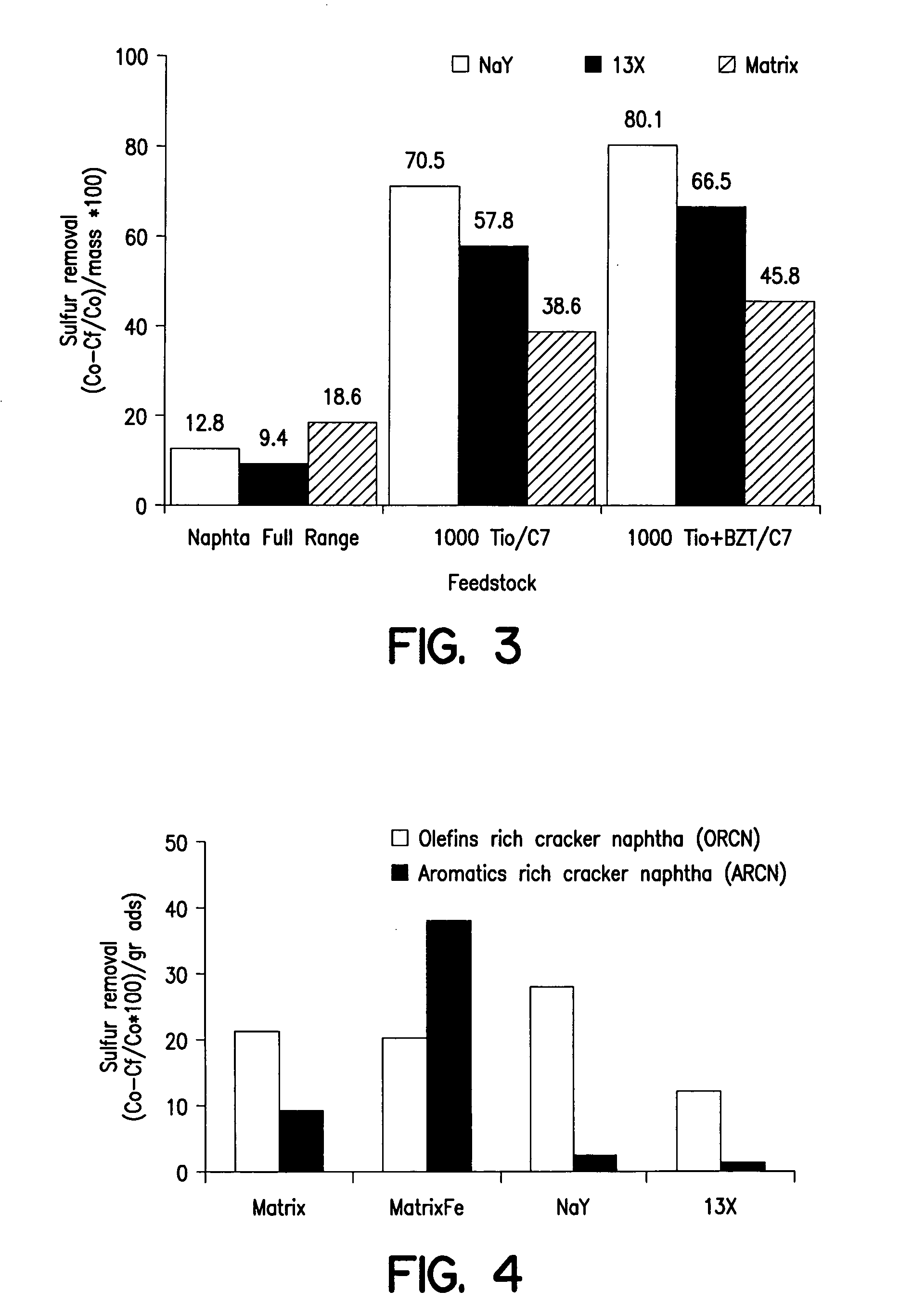Selective sulfur removal from hydrocarbon streams by adsorption
a technology of adsorption and hydrocarbons, applied in the field of adsorbents, can solve the problems of affecting the hydrogen balance in the refinery, the performance of available hydrotreatment technologies with feedstocks,
- Summary
- Abstract
- Description
- Claims
- Application Information
AI Technical Summary
Benefits of technology
Problems solved by technology
Method used
Image
Examples
example 1
[0043] This example illustrates the measurement of surface acidity of the adsorbent in accordance with the invention. The surface acidity is measured as the amount of irreversibly adsorbed pyridine on samples of the relevant materials. The samples were subjected to calcination at various temperatures between about 400° C. and about 800° C. A sample of about 10-20 mg is loaded onto the bucket of a micro-electrobalance and fully outgassed. Then, it is subjected to pyridine vapor at 30° C. up to saturation. A helium flow is used for outgassing at various temperatures (30, 100 and 200° C.) . The amount of irreversibly adsorbed pyridine at each temperature is measured as μmol of pyridine per m2 of adsorbent sample. The amount measured at 30, 100 and 200° C. is taken as Weak, Medium and Strong Acidity, respectively.
[0044] Three Fe (III)-containing samples, supported onto different materials were considered. A siliceous mesoporous matrix, alumina and silica were used as support of the Fe-...
example 2
[0045] This example illustrates the measurement of surface metal dispersion of samples of the relevant materials in accordance with the invention. The surface metal dispersion is measured as the surface metal atom concentration per surface atom concentration of the support material. Surface atom concentrations are measured by X-Ray Photoelectron Spectroscopy (XPS) in a duly calibrated LHS-11 equipment. The respective samples were outgassed in a high vacuum chamber, up to a vacuum better than 10−8 torrs. Table 2 shows the results, which can be taken as an indirect measurement of the metal particle size, the larger the dispersion, the smaller the particle size.
TABLE 2Surface metal dispersion (Sup = Si or Al)[Fe]at / [Supat]Fe-Matrix135 Fe-Alumina73Fe-Silica64
[0046] Thus, the smallest metal particles can be found on the surface of the adsorbent in accordance with the invention. Meanwhile, the larger metal particles were found on the surface of the silica-supported sample.
example 3
[0047] This example illustrates the adsorption of thiophene and benzothiophene from test heptane solutions using the adsorbent according to this invention. The adsorbent was prepared according to this invention, and having 9.4 wt % of iron. FIG. 1 illustrates the adsorption isotherms for the various test solutions. As shown, in both cases the adsorbent effected significant reductions in sulfur for various loadings of the test solution. Further, the way of incorporating the metal, did not significantly affect the adsorption of sulfur.
PUM
| Property | Measurement | Unit |
|---|---|---|
| Temperature | aaaaa | aaaaa |
| Temperature | aaaaa | aaaaa |
| Temperature | aaaaa | aaaaa |
Abstract
Description
Claims
Application Information
 Login to View More
Login to View More - R&D
- Intellectual Property
- Life Sciences
- Materials
- Tech Scout
- Unparalleled Data Quality
- Higher Quality Content
- 60% Fewer Hallucinations
Browse by: Latest US Patents, China's latest patents, Technical Efficacy Thesaurus, Application Domain, Technology Topic, Popular Technical Reports.
© 2025 PatSnap. All rights reserved.Legal|Privacy policy|Modern Slavery Act Transparency Statement|Sitemap|About US| Contact US: help@patsnap.com



